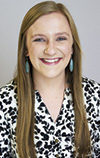Troutman believed the contents of whole milk were often misunderstood, so he set out to find a simple yet effective way to promote its consumption.
Knowing whole milk contains 3.25% fat, Troutman decided to promote it as 97% fat-free to inform consumers of the actual fat content. With that idea in mind, Troutman painted, “Drink local whole milk 97% fat free” on the side of a wrapped round bale. He placed it on the edge of his pasture for drivers passing by to see. While Troutman confesses he didn’t know quite what to expect, his so-called “baleboards” were a catalyst for conversations between him and community members at the grocery store, on his farm and around town.
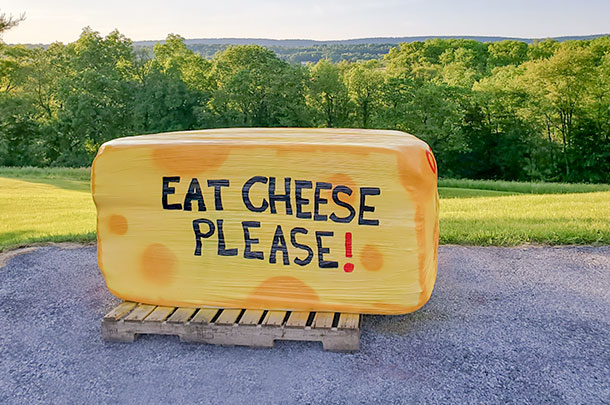
The beginning of a movement
As other farmers caught wind of the concept, baleboards began popping up along other roads throughout Pennsylvania. Sherry Bunting, a freelance agricultural writer, heard about the idea. She too noticed the lack of understanding many consumers have about the contents of milk and became involved behind the scenes on social media, answering technical questions and helping with correspondents and content.
“Confusion stems from the way in which whole milk is labeled,” Bunting says. “Part of the dairy checkoff system restricts labeling whole milk as virtually 97 percent fat-free or even 3.25 percent fat. Consumers are missing that connection and being misled.”
In search of a grassroots way to increase consumer awareness about the health benefits of whole milk, a group of farmers and industry professionals came together in mid-February to form an official campaign now known as 97 Milk. Current chairman of the board, G.N. Hursh, says that in terms of promotion, the checkoff dollars have promoted cheese and butter quite well, and the demand for those products has steadily increased. As for fluid milk, the consumption numbers appear to be declining. Hursh says, “So it’s pretty clear where the missing link is.”
The group wanted to address that area of improvement by building off of the momentum gained with baleboards. After discussions and brainstorming, Jackie Behr, an agri-business person heavily involved with dairy farmers, suggested the creation of a website. The team agreed, and Behr began asking friends from non-ag backgrounds what questions they had regarding milk. Within one week, she and Bunting used that information to create the website.
“So many people think whole milk is anywhere from 5 to 50 percent fat,” Bunting says. “And it’s really not.” The 97 Milk team seeks to properly educate while clearing up common misconceptions about milk contents. The website serves as an informative site for consumers to learn about whole milk and how it compares to other beverages – both dairy and nondairy.
“97 Milk is trying to fill that void by educating consumers about the benefits of whole milk and letting them decide what’s best for them – providing them with good, solid information,” Hursh says.
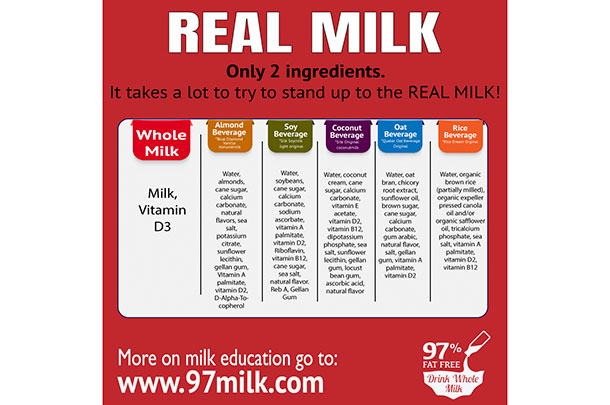
Online presence boosts impact
Within four weeks of 97milk.com going live, it had 1.2 million hits and over 150,000 interactions. Bunting says, “It’s just amazing the amount of people who have been touched.”
In addition to the website, 97 Milk has a presence on Twitter and Facebook with more than 6,500 followers. Between the three combined, Bunting says people from a variety of locations are connecting with 97 Milk and the campaign. From Pennsylvania to Wisconsin, New York to Virginia, Maryland to Texas and even the countries of Canada, England, Chile and Argentina, agriculturalists and consumers alike are connecting.
In the U.S., the 97 Milk board envisions each state with a group educating consumers and directing them to 97milk.com. Baleboards, bumper stickers, window decals, magnets, chip clips, social media posts, the website and public interactions are just some of the forms whole milk advocacy has taken.
Family Farm Days at Oregon Dairy in Lancaster County, Pennsylvania, was a recent addition to advocating for whole milk. A team of advocates hosted a 97 Milk booth at the three-day June Dairy Month educational event. The free public event welcomed consumers for a firsthand experience on the family farm to increase awareness of the important role farms and agri-businesses play.
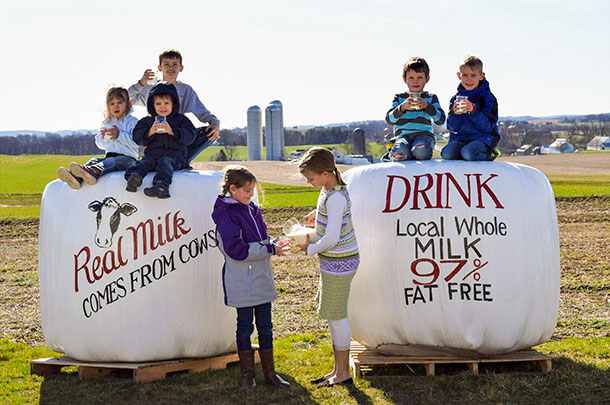
Policymakers hear plea for whole milk
Not only have these efforts drawn attention of the general public, but some legislatures have started to notice the push for whole milk, particularly in schools.
“I think the baleboards have created more of an awareness among legislatures about the dairy crisis that we’re in and some of the issues with the regulatory processes that affect milk in schools,” Bunting says. “It’s given us an education avenue.”
Chairman of the House of Agriculture Committee Collin Peterson (D-Minnesota) and U.S. Rep. Glenn “GT” Thompson (R-Pennsylvania) introduced the Whole Milk for Healthy Kids Act of 2019. In a press release from Thompson’s office, the two shared their thoughts on the importance of providing whole milk in schools.
“Milk is the number one source of nine essential nutrients in the diets of our students, but if they don’t drink it, these health benefits are lost,” Thompson says. “It is my hope that the Whole Milk for Healthy Kids Act will bring a wider range of milk options to American lunchrooms so students can choose the kind they love best.”
“I’m proud to join Congressman Thompson in this effort that will provide more choices for nutritious and healthy milk to kids in schools,” Peterson stated in the release, “and a valuable market for dairy farmers in Minnesota, Pennsylvania and nationwide at a time when they’re continuing to face extremely difficult market conditions.”
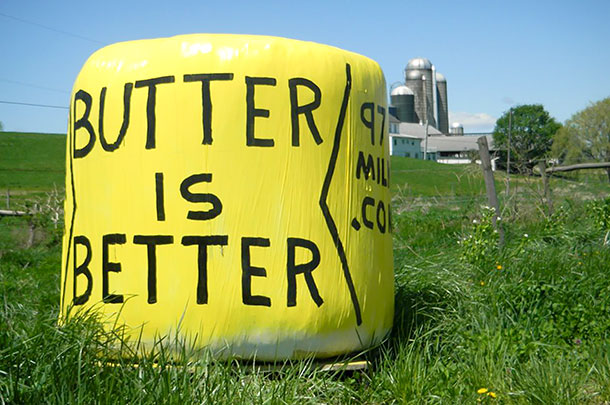
Cheese, butter and beyond
As the push to provide school children with whole milk proceeds, 97 Milk and fellow farmers will continue to advocate for the consumption of various dairy products, not just whole milk, on the worldwide scale.
“Eat cheese please!” and “Butter is better” have recently been painted on bales, accompanied by “97milk.com.” Each bale draws attention to the website where people can find specific information about the products they are consuming.
“There’s so much negative information out there that getting the positive message in front of consumers – I believe – is really important,” Behr says.
Bunting adds, “The goal [of 97 Milk] is not to bash any other product, but to put the facts out there.”
97 Milk strives to educate with honesty and integrity and encourages others to join in their mission of promoting nutritious dairy products for all. ![]()
Courtney Moser is a 2019 Progressive Dairy intern.
PHOTO 1: Nelson Troutman paints round bales to promote the consumption of whole milk which is virtually 97% fat-free. Troutman was the first to spark the “baleboard” idea by placing one along the road of his farm near Richland, Pennsylvania.
PHOTO 2: Jaclyn Troutman Stoner, Nelson Troutman’s daughter, was joined by her friend Katie Pchola-Miller in creating this variation featuring cheese using a large square bale. “Eat Cheese Please” is proudly displayed near Myerstown, Pennsylvania.
PHOTO 3: Social media posts and website content from 97 Milk provide fact-based information for consumers to gain a greater understanding of whole milk. This milk comparison, created by Jackie Behr, received over 530 reactions, 160 comments, 4,400 shares and reached more than 522,500 people via Facebook.
PHOTO 4: The Rohrer family of Meadow Lane Dairy near Lancaster, Pennsylvania, made their baleboards a family affair. Friend and artist Brenda Reist painted the bales. Included in the photo are some of Glenn and Joyce Rohrer’s grandchildren: Leila, Brody and Tage (left), Alivia and Jada (center) and Bennet and Logan (right).
PHOTO 5: Another baleboard creation by Nelson Troutman highlights the message that “Butter is Better.” Each bale, regardless of message, incorporates 97milk.com to encourage viewers to visit their website designed to educate consumers about the contents of whole milk. Photos courtesy of 97milk.com
